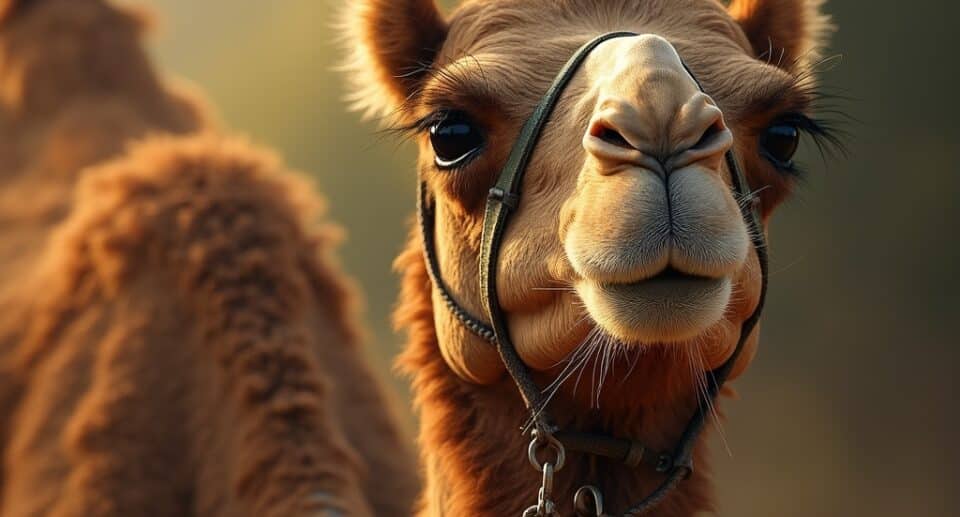Camel spiritual meaning

Camels have transcended their physical presence to become powerful spiritual symbols across diverse cultures and traditions throughout history. Their remarkable adaptations for desert survival, unwavering patience, and ability to journey through harsh landscapes have inspired spiritual teachings about resilience, inner strength, and the transformative power of life’s journeys.
Key Takeaways
- Camels represent spiritual endurance and the ability to persevere through difficult life phases
- Their journey symbolism connects to life transitions and personal transformation paths
- In many traditions, camels symbolize abundance and prosperity due to their historical economic value
- The camel embodies divine submission and spiritual humility through its patient service
- As spiritual guides, camels teach intuitive navigation through life’s challenging terrains
Introduction to Camel Symbolism
The spiritual significance of camels stretches back thousands of years, with these magnificent creatures holding special symbolic meaning across numerous ancient civilizations. From the sands of the Middle East to the trade routes of Asia, camels have been revered not merely as beasts of burden but as embodiments of spiritual qualities that humans aspire to develop.
These “ships of the desert” carry deep metaphorical weight in spiritual traditions. Their ability to traverse harsh landscapes has made them universal symbols of inner strength and perseverance. The camel’s patient nature and remarkable adaptations have inspired spiritual seekers to find meaning in life’s challenging journeys.
Across different cultural contexts, camels represent the wisdom that comes from quiet endurance. Their steady pace through difficult terrain mirrors the spiritual journey many traditions describe as the path to enlightenment or connection with divine wisdom.
Endurance: The Desert Master’s Spiritual Lessons
The camel’s extraordinary physical adaptations offer profound spiritual metaphors for resilience. Unlike any other mammal, camels can survive losing up to 40% of their body weight in water—a biological marvel that spiritual teachings translate into lessons about enduring life’s driest seasons.
Their remarkable temperature adaptability—surviving from -30°C to +40°C—reminds us of our own capacity to withstand the extremes of our emotional and spiritual climates. This adaptability isn’t just physical but represents the spiritual flexibility needed to navigate life’s unpredictable circumstances.
The camel’s famous humps store fat, not water as commonly misunderstood, providing a reservoir of energy for lean times. This biological fact translates beautifully into spiritual teachings about conserving inner resources and preparing for challenging periods in our spiritual journey.
In dream interpretation traditions, camels often appear as messengers of endurance, suggesting the dreamer possesses untapped reserves of strength. Meditative practices sometimes invite participants to embody camel-like patience, cultivating the ability to persist through discomfort without complaint.
Sacred Journeys and Transitions
The image of camel caravans along ancient trade routes like the Silk Road serves as a powerful metaphor for life’s sacred journeys. These slow, deliberate progressions across challenging terrain mirror our own passages through life’s transformative experiences.
Archaeological evidence reveals the spiritual significance of camels in nomadic cultures. Safaitic rock art depicting camels dates back thousands of years, marking not just physical migrations but spiritual passages and transitions in nomadic life cycles.
The steady, measured pace of the camel through harsh landscapes has become symbolic of mindful transitions between life stages. Unlike the rush of modern life, the camel’s journey represents intentional movement that honors the process of change rather than merely seeking the destination.
In prophetic dreams across several traditions, camels often appear as guides through transitional periods. Their presence in such dreams typically signals an upcoming passage that requires patience and endurance—qualities the camel embodies perfectly.
Abundance and Prosperity Signs
Throughout history, camels have represented material and spiritual wealth. In ancient desert societies, a person’s prosperity was often measured by the number of camels they owned, making these animals potent symbols of abundance.
This association with prosperity continues in modern contexts. The Arab Bank’s adoption of a camel logo reflects the enduring connection between these animals and economic well-being in Middle Eastern cultural consciousness.
Dream interpreters in various traditions view camels as harbingers of financial blessing. The appearance of a camel in dreams is often interpreted as a sign of forthcoming prosperity or the dreamer’s capacity to sustain wealth through difficult times.
The elaborate camel beauty contests held in the UAE and Saudi Arabia celebrate more than physical aesthetics—they honor camels as living symbols of cultural wealth and heritage. These contests represent the spiritual abundance that comes from honoring traditional values and connections to ancestral wisdom.
Divine Submission and Spiritual Humility
Biblical narratives frequently highlight the camel’s obedience and loyalty as exemplars of proper spiritual relationship with divine guidance. The camel’s willingness to kneel for loading and unloading symbolizes the spiritual virtue of humility before higher powers.
Religious texts present a paradoxical view of camels. While Leviticus 11:4 classifies them as unclean animals, many spiritual traditions venerate them precisely because they embody virtues of service and acceptance of burden.
The camel’s acceptance of its role mirrors spiritual teachings about finding purpose through service. Their patient carrying of burdens across difficult terrain represents the spiritual strength that comes from accepting one’s purpose and challenges with grace.
Many spiritual seekers find inspiration in the camel’s blend of strength and submission. This duality suggests that true power comes not from dominance but from the willing acceptance of one’s path and burdens—a central teaching in numerous wisdom traditions.
Cultural and Religious Significance
In Jewish mystical tradition, The Zohar describes “flying camels” as serpent-like guardians, representing supernatural protection along spiritual journeys. These mystical camels transcend ordinary understanding, suggesting the spiritual realm’s mysterious nature.
Arab cultural reverence for camels appears extensively in historical Safaitic inscriptions, where these animals frequently feature in tribal symbols and spiritual narrative art. These depictions suggest the camel’s role as a mediator between human and divine realms.
European perspectives on camel symbolism evolved dramatically over centuries. Initially viewed as exotic emblems of Oriental wealth, camels later became associated with eastern spiritual traditions that Europeans often misunderstood or exoticized.
For Bedouin peoples, camels transcend mere symbolism to become integrated into family structure and spiritual life. The intimate relationship between humans and camels in desert cultures creates a spiritual bond that influences religious practices and worldviews.
Wisdom Carriers and Spiritual Guides
Many spiritual practitioners view the camel as a power animal capable of guiding souls through metaphorical deserts—periods of spiritual dryness or uncertainty. Connecting with camel energy is believed to provide direction during times when the spiritual path seems unclear.
Bedouin wisdom traditions frequently center on careful observation of camel behavior. These desert dwellers developed spiritual insights by watching how camels navigate challenging environments, extracting lessons about patience and timing.
The camel’s legendary ability to find water in seemingly barren landscapes serves as a metaphor for intuitive spiritual guidance. This natural instinct parallels the human capacity to sense truth and direction beyond rational understanding.
Desert survival knowledge passed down through generations of camel handlers contains not just practical advice but spiritual wisdom about resource management, patience, and finding sustenance in unexpected places—all applicable to navigating life’s challenges.
Modern Applications of Camel Symbolism
Contemporary wellness and mindfulness practices increasingly draw on camel symbolism to teach resilience in uncertain times. The camel’s adaptations offer perfect metaphors for developing inner resources that sustain us through difficulties.
Self-sufficiency—a quality exemplified by the camel’s biology—has become a valued spiritual virtue in modern individualistic societies. The camel’s ability to carry its own water and food reserves inspires those seeking independence in their spiritual journeys.
Sustainable resource management, a growing concern in our environmentally conscious age, finds a natural model in camel biology. These animals’ efficient use of limited resources offers spiritual lessons about consumption and conservation.
Meditative practices sometimes incorporate camel imagery to cultivate patience and steadiness. Visualizing the camel’s measured pace can help practitioners develop the mental discipline needed for consistent spiritual practice in a distracting world.
Finding Your Camel Spirit Guide
Developing a personal connection to camel energy begins with acknowledging their qualities you wish to cultivate. Spend time learning about these remarkable creatures, not just as biological entities but as carriers of ancient wisdom about endurance and journey.
Meditative practices designed to invoke camel endurance might involve visualizing yourself as a camel crossing a challenging desert landscape. This visualization can help access inner reserves of strength during difficult life transitions.
Dream work techniques focusing on camel symbolism encourage paying special attention when these animals appear in dreams. Keeping a dream journal to record camel appearances and the accompanying emotions can reveal personal patterns and messages from your subconscious.
The daily application of camel wisdom doesn’t require desert travel—it can be as simple as adopting a measured pace through challenges, conserving emotional energy when facing difficulties, or cultivating the patience to endure temporary discomfort for long-term gain. These practical applications transform ancient camel symbolism into relevant guidance for modern challenges.
This article explores how camels have become powerful spiritual symbols across cultures and history. They’re revered for their desert survival skills, patience, and journey symbolism, inspiring teachings about resilience and transformation. Camels represent spiritual endurance, life transitions, abundance, divine submission, and intuitive guidance through difficult terrains. Their ability to store resources and navigate harsh environments offers metaphors for perseverance and inner strength. Beyond their physical attributes, they’ve been integrated into religious narratives, dream interpretations, and modern mindfulness practices.
| Symbolic Meaning | Description |
|---|---|
| Spiritual Endurance | Represents perseverance through life’s challenges and difficult phases |
| Sacred Journeys | Symbolizes life transitions and personal transformation paths |
| Abundance | Signifies prosperity and wealth in multiple cultural contexts |
| Divine Submission | Embodies spiritual humility and willing acceptance of one’s path |
| Intuitive Guidance | Teaches navigational wisdom through life’s challenging terrains |














